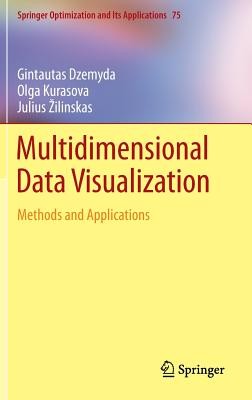
- We will send in 10–14 business days.
- Author: Gintautas Dzemyda
- Publisher: Springer
- Year: 2012
- Pages: 252
- ISBN-10: 144190235X
- ISBN-13: 9781441902351
- Format: 15.5 x 23.4 x 2 cm, kieti viršeliai
- Language: English
- SAVE -10% with code: EXTRA
Reviews
Description
This book highlights recent developments in multidimensional data visualization, presenting both new methods and modifications on classic techniques. Throughout the book, various applications of multidimensional data visualization are presented including its uses in social sciences (economy, education, politics, psychology), environmetrics, and medicine (ophthalmology, sport medicine, pharmacology, sleep medicine).
The book provides recent research results in optimization-based visualization. Evolutionary algorithms and a two-level optimization method, based on combinatorial optimization and quadratic programming, are analyzed in detail. The performance of these algorithms and the development of parallel versions is discussed.
The encorporation of new visualization techniques to improve the capabilies of artificial neural networks (self-organizing maps, feed-forward networks) is also discussed.
The book includes over 100 detailed images presenting examples of the different visualization techniques that are presented.
This book is intended for scientists and researchers in any field of study where complex and multidimensional data must be represented visually.
EXTRA 10 % discount with code: EXTRA
The promotion ends in 22d.20:43:21
The discount code is valid when purchasing from 10 €. Discounts do not stack.
- Author: Gintautas Dzemyda
- Publisher: Springer
- Year: 2012
- Pages: 252
- ISBN-10: 144190235X
- ISBN-13: 9781441902351
- Format: 15.5 x 23.4 x 2 cm, kieti viršeliai
- Language: English English
This book highlights recent developments in multidimensional data visualization, presenting both new methods and modifications on classic techniques. Throughout the book, various applications of multidimensional data visualization are presented including its uses in social sciences (economy, education, politics, psychology), environmetrics, and medicine (ophthalmology, sport medicine, pharmacology, sleep medicine).
The book provides recent research results in optimization-based visualization. Evolutionary algorithms and a two-level optimization method, based on combinatorial optimization and quadratic programming, are analyzed in detail. The performance of these algorithms and the development of parallel versions is discussed.
The encorporation of new visualization techniques to improve the capabilies of artificial neural networks (self-organizing maps, feed-forward networks) is also discussed.
The book includes over 100 detailed images presenting examples of the different visualization techniques that are presented.
This book is intended for scientists and researchers in any field of study where complex and multidimensional data must be represented visually.


Reviews